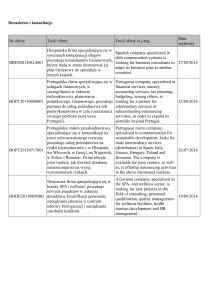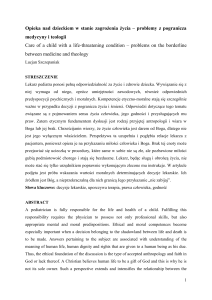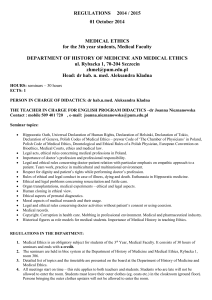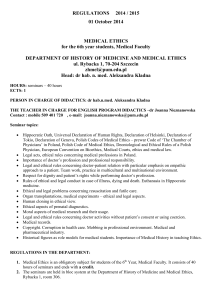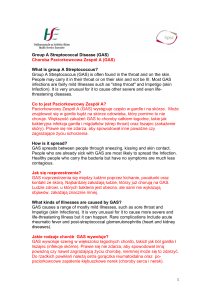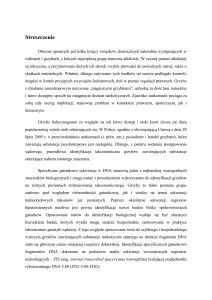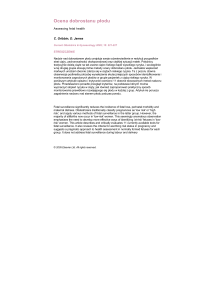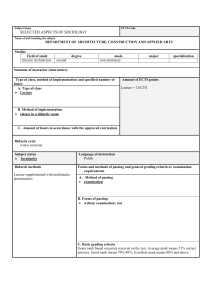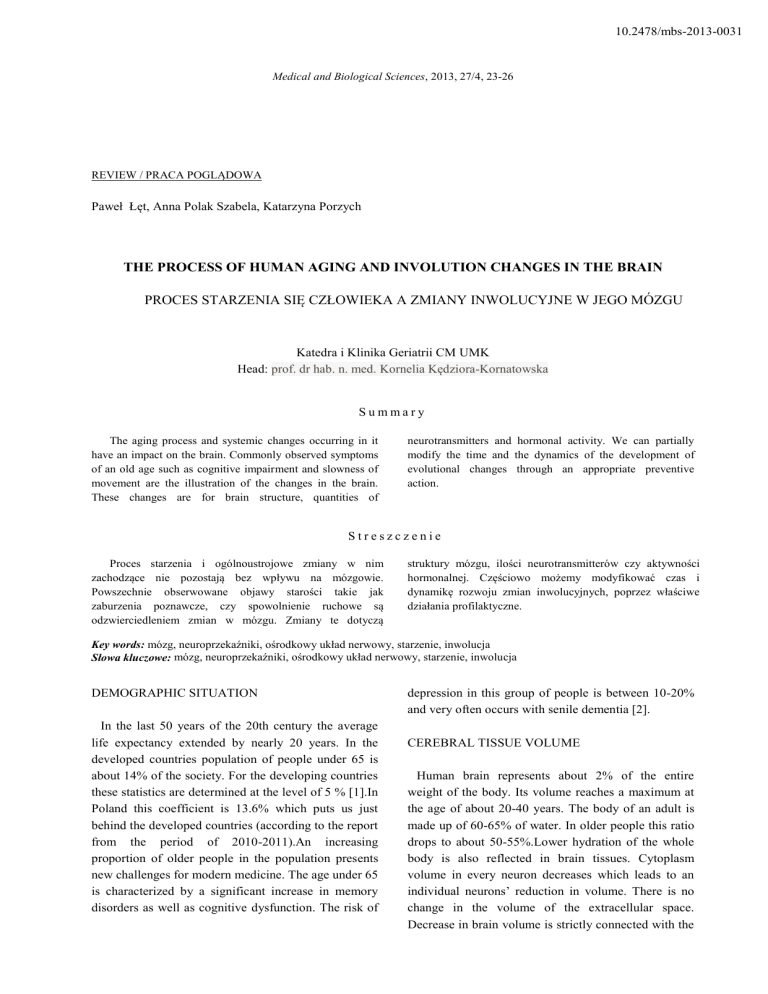
10.2478/mbs-2013-0031
Medical and Biological Sciences, 2013, 27/4, 23-26
REVIEW / PRACA POGLĄDOWA
Paweł Łęt, Anna Polak Szabela, Katarzyna Porzych
THE PROCESS OF HUMAN AGING AND INVOLUTION CHANGES IN THE BRAIN
PROCES STARZENIA SIĘ CZŁOWIEKA A ZMIANY INWOLUCYJNE W JEGO MÓZGU
Katedra i Klinika Geriatrii CM UMK
Head: prof. dr hab. n. med. Kornelia Kędziora-Kornatowska
Summary
The aging process and systemic changes occurring in it
have an impact on the brain. Commonly observed symptoms
of an old age such as cognitive impairment and slowness of
movement are the illustration of the changes in the brain.
These changes are for brain structure, quantities of
neurotransmitters and hormonal activity. We can partially
modify the time and the dynamics of the development of
evolutional changes through an appropriate preventive
action.
Streszczenie
Proces starzenia i ogólnoustrojowe zmiany w nim
zachodzące nie pozostają bez wpływu na mózgowie.
Powszechnie obserwowane objawy starości takie jak
zaburzenia poznawcze, czy spowolnienie ruchowe są
odzwierciedleniem zmian w mózgu. Zmiany te dotyczą
struktury mózgu, ilości neurotransmitterów czy aktywności
hormonalnej. Częściowo możemy modyfikować czas i
dynamikę rozwoju zmian inwolucyjnych, poprzez właściwe
działania profilaktyczne.
Key words: mózg, neuroprzekaźniki, ośrodkowy układ nerwowy, starzenie, inwolucja
Słowa kluczowe: mózg, neuroprzekaźniki, ośrodkowy układ nerwowy, starzenie, inwolucja
DEMOGRAPHIC SITUATION
In the last 50 years of the 20th century the average
life expectancy extended by nearly 20 years. In the
developed countries population of people under 65 is
about 14% of the society. For the developing countries
these statistics are determined at the level of 5 % [1].In
Poland this coefficient is 13.6% which puts us just
behind the developed countries (according to the report
from the period of 2010-2011).An increasing
proportion of older people in the population presents
new challenges for modern medicine. The age under 65
is characterized by a significant increase in memory
disorders as well as cognitive dysfunction. The risk of
depression in this group of people is between 10-20%
and very often occurs with senile dementia [2].
CEREBRAL TISSUE VOLUME
Human brain represents about 2% of the entire
weight of the body. Its volume reaches a maximum at
the age of about 20-40 years. The body of an adult is
made up of 60-65% of water. In older people this ratio
drops to about 50-55%.Lower hydration of the whole
body is also reflected in brain tissues. Cytoplasm
volume in every neuron decreases which leads to an
individual neurons’ reduction in volume. There is no
change in the volume of the extracellular space.
Decrease in brain volume is strictly connected with the
24
Paweł Łęt et al.
intracellular changes in nervous tissues. Mass of the
brain decreases between the 3rd and the 8th decade of
life by about 10%[3].Not all of the brain structures lose
the same volume of water in connection with the loss
of water. Cortical centers consisting of small neurons
lose only about 5-8% of its surface. Losses in the fields
of somatosensory and motor cortex are composed of
large neurons and reach even 15%.Starting from the
age of 25 a hippocampal mass decreases by about 23% in 10 years. The rate of decline increases after 75
and is up to1% per year. [4].Mass of the white matter
of the brain decreases quite evenly. Loss of the grey
matter is characterized by differentiation that depends
on the region of the brain. The defects in the frontal
and parental cortex are distinct. Smaller losses are
recorded in temporal and occipital cortex[5].
PLASTICITY IN THE BRAIN AND CHANGES
IN NEURONS
Reduction of intracellular water translates directly
into increased protein content inside the neuron. This
way the neurons can accumulate pathological proteinsamyloids interfering with their function. As the body
grows older, the volume of glial cells in the brain
increases. The rate of synthesis of myelin decreases
although the astrocytes are not dimnished. The length
of myelinated axons decreases by approximately 2734%[3]. Impoverishment of a dendritic tree occurs in
the aging neuron as well as disappearance of the spikes
and reduction of the number of synaptic connections.
The nerve cells' ability to multiply decreases which
leads
to
a
reduction
in
their
total
number[6].Cerebellum is very sensitive to change in
reducing number of neurons(the largest number of
dying Purkinje cells).Significant morphological
changes occur in the brain motor cortex. Dysfunction
of the brain structures and motor cortex is often the
cause of imbalances and coordination in the elderly.
An adult up to 80 years looses an average of 3-5% of
the nerve cells in comparison to the value in adulthood.
The greatest loss of neurons occurs in the cerebral
cortex (10-17%) and striatum(8%).The processes of
neurogenesis and synaptogenesis slow down with age.
The number of synapses and dendritic branching
decreases. The ability to create persistent interneuronal
connections is reduced. Creating new connections
between neurons may be impeded by the specific types
of proteins and insoluble pigments that accumulate in
the intercellular space. Lipofuscin, neuromelanin and
senile plaques belong to them[6,8].Brain has a natural
ability to adapt through the reorganization of its
structures, synaptogenesis and neurogenesis. The
younger
person’s
the
brain
plasticity
is
greater[7].Injuries or damages to the brain at early age
give big changes to almost full or total restoration
function of the damaged parts o f the brain in
undamaged areas of the brain. Plasticity allows us to
adapt to changing external and internal environment.
With the ability to structural and functional
reorganization, brain is capable of self-repair,
adaptation, learning and remembering.
VASCULAR CHANGES
Cerebral vessels become less flexible, thinner and
more susceptible to damage with age [9].Disorders of
the proportion of collagen compared to elastin lead to
the unfavorable changes in blood vessels. The level of
elastin in vessels decreases and collagen grows.
Vascular endothelium becomes less excitable on the
action of acetylcholine and bradykinin. The vessel
calcification and stiffness as well as smooth muscle
hypertrophy occur [10].
With age synthesis of nitric oxide decreases (NO)
NO gives relaxant effects as well as works extensively
on vessels and takes part in the regulation of blood
flow [11].Development of atherosclerosis is a frequent
problem in the elderly. Cerebral atherosclerosis impairs
perfusion and autoregulation of blood flow. This leads
to deterioration of brain metabolism, its under-nutrition
and oxygenation. These changes increase the risk of
cerebral stroke [4,12].
NEUROTRANSMISSION IN THE ELDERLY
The greatest decline of neurotransmitters is
noticeable in a dopaminergic, cholinergic and
serotonergic system. The decrease also applies to other
neurotransmitters e.g.dehydroepiandrosterone, GABA
acids. Reducing the amount of neurotransmitter,
worsening its receptor, binding and loss of adequate
receptors for neurotransmitter are the cause of the
impaired neurotransmission [6].
SEROTONERGIC AND GLUTANERGIC SYSTEM
Disorders of the serotoergic transmission may be the
cause of depressive disorders and depression
[13].Glutamic acid is one of the most important
The process of human aging and involution changes in the brain
neurotransmitters that stimulate our brain to act.
Activating actions on neurons give positive effects on
the entire brain. Over the years, there has been an
increase of receptors AMPA compared to NMDA in
the glutanergic system and thus, the brain plasticity
reduces [13].
CHOLINERGIC SYSTEM
There is a clear correlation between the level of the
brain cortex and the incidence and severity of dementia
changes. The number of cholinergic cells in the
Meynert nucleus drops by about 25-70%.This leads to
a significant decrease in neurotransmitter because in
Meynert nucleus there is about 90% of synthesized
acetylcholine. The activity of choline acetyltransferasethe major enzyme involved in the synthesis of
acetylcholine [14].
25
GAMMA-AMINO-BUTYRIC ACID
AND MELATONIN
GABA plays an important role as a neurotransmitter
in the inhibitory synapses. Stimulation of the receptors
leads to opening the chloride channel and
hyperpolarization of postsynaptic membrane. GABA is
necessary for the psychomotor calm and for reducing
muscle tension. Decreased GABA may cause epileptic
seizures, restless leg syndrome and difficulty in falling
asleep [8].Melatonin is working agonist hormone in
relation to the GABA produced in the pineal gland. Its
secretion declines with age which is associated with
sleep disturbance and deterioration of its quality
[13].The reuptake of the neurotransmitter in the body
also decreases [14].
PATHOLOGICAL CONDITIONS ASSOCIATED
WITH NEUROTRANSMISSION DISORDERS
DOPAMINERGIC SYSTEM
Impairment of dopaminergic transmission largely
depends on reducing the number of dopamine receptors
D1 D2 in the caudate in putamen (?).The ability to bind
dopamine decreases. Significant reduction of the
number of dopamine receptors occurs in the nigra
substantia. Dopamine reuptake also decreases
[13].Dopamine level decreases by about 6% for each
decade after 40 years of age. The loss of substantia
nigra cells after 65 reaches even 10% per decade.
Dopamine deficiency can lead to disorders of motor
function such as problems with coordination of
movements and slowness of walking and movement.
[7].
We can see how important GABA is for our body
watching people with the Huntington disease. Drastic
decrease in the neurotransmitter is responsible for
dyskinesias and for the characteristic movements
occurring in this disease[8]. Alzheimer’s disease is
associated with an excessive acetylcholine decrease to
a lesser extent with norepinephrine, dopamine and
serotonin. In Parkinson's disease such clinical signs as
an increased muscle tone stooped posture of a body or
motor dysfunction are caused by dopamine deficiency.
We have to keep in mind that the physiological
neurotransmitters' decline is natural in the elderly. The
diseases listed above take place when the level of
neurotransmitters decreases below the physiological
norms[16].
DEHEDROEPIANDROSTERONE (DHEA)
PREVENTION
Dehydroepiandrosterone boosts the process of new
neuron formation as well as enhances memoryband
calms. A total concentration of DHEA in the body is
observed between 20-30 years. Cortisol working
destructive to neurons is released in stressful situations.
Dehydroepiandrosterone acts neuroprotectively and
protects neurons from the toxic effects of cortisol
[15].DHEA decrease is more severe in men. It is
strictly connected with the disappearance of reticular
layerbof the adrenal cortex which produces DHEA
[12].DHEA has also an antioxidant, anti-depressant,
anti-sclerotic and improving memory influence [10].
Aging is an inevitable process. We cannot stop all the
changes that take place in our body but by appropriate
preventive actions we can significantly slow them
down. Focusing on maintaining a good brain condition
we should especially take care of a good diet and
regular mental activity. Through mental activity we
can understand all the activities forcing our brain to
work harder. This can be presented by crosswords,
games requiring logical thinking e.g. chess or work,
familly and social life [12]. If we want our diet to be
correct, we cannot miss such ingredients as A B
vitamin (especially B3 B6 B9 B12 C E K) as well as
26
Paweł Łęt et al.
minerals and microelements such as phosphorus,
potassium, magnesium, zinc and boron. Such a diet
supports activity of the brain, has a neuroprotective
action, improves memory and concentration [17].
SUMMARY
Despite the changes that occur with age in our brain,
the old age should not only be considered in terms of
loss.
At the age of about 75 years of age our brain has
significant possibilities for compensation arising from
the deficiencies of aging processes. Such an action is
even more complex dendritic tree in the elderly. These
abilities are clearly smaller after finishing 75 years of
age but still exist[18].An appropriate preventive can
keep a very good brain condition until death.
REFERENCES
1. Jarosz M.: Psychologia starzenia się i starości, oraz
niektóre zasady postępowania z ludżmi w wieku
podeszłym.W: Prusiński A. (red.). Neurogeriatria,
praktyczne problemy neurologi w wieku podeszłym,
Czelej, Lublin 2004; 19-29.
2. Strosznajder J.B., Mossakowski M.J.: Mózg a starzenie,
Upowszechnianie nauki – Oświata ,,UN-O”, Warszawa
2001; 7-11.
3. Dąbrowski Z., Żołądź J.A., Marchewka A.: Fizjologia
starzenia się, profilaktyka i rehabilitacja, Wydawnictwo
Naukowe PWN, Warszawa 2012; 102-103.
4. Owecki
M.K.,
Michalak
S.,
Kozubski
W.:
Psychopatologia chorób układu nerwowego w wieku
podeszłym. Neurologia i neurochirurgia polska. 2011;
45: 161-168.
5. Ocena procesu starzenia się mózgu metodą protonowej
spektroskopii rezonansu magnetycznego, Kraków 2002,
Andrzej Urbanik.
6. Wójcik K.: Neurobiologia rozwojowa i inwolucyjna
plastyczności mózgu. Rocz. Pam. 2011: 57; 162-170.
7. Martin G.N.: Neuropsychologia, Wydawnictwo lekarskie
PZWL, Warszawa 2001; 323-325.
8. Niewiadomska G.: W poszukiwaniu molekularnych
mechanizmów pamięci. W: Mostowik K., Betlejewska E.
(red.). Mózg a zachowanie. Wydawnictwo naukowe
PWN S.A., Warszawa 2005; 544-567.
9. Makowska G., Sadynica S.A., Kochanowski J.: Wybrane
procesy endokrynne a proces starzenia się mózgu.
Terapia. 2008: 10; 30-33.
10. Kurpesa M., Krzemińska-Pakuła M.: Starzenie się układu
krążenia. W: Karasek M.(red.). Aspekty medyczne
starzenia się człowieka, Łódzkie towarzystwo naukowe,
Łódź 2008; 7-33.
11. Strosznajder J.B., Chalimoniuk M.: Tlenek azotu w
starzeniu i chorobach neurodegeneracyjnych. W:
Mossakowski M.J., Strosznajder J.B. (red.). Mózg a
starzenie, Upowszechnianie nauki – Oświata ,,UN-O”,
Warszawa 2001; 51-66.
12. Zawidzka I., Bienert A., Grześkowiak E., Ratajczak N.:
Rola witamin w prewencji chorób związanych ze
strarzeniem. Nowiny lekarskie. 2009; 78: 168-174.
13. Wrona D., Jurkowski M.K., Bobek-Billewicz B.,
Ćwiklińska-Jurkowska
M.:
Neurotransmittery
i
neuromodulatory snu. Sen. 2005: 5; 56-64.
14. Strosznajder J.B.: Mózg a starzenie, Upowszechnianie
nauki – Oświata ,,UN-O”, Warszawa 2001; 67-78.
15. Babuśka-Roczniak
M.,
Roczniak
W.:
Rola
dehydroepiandrosteronu w procesie starzenia. Problemy
medycyny rodzinnej. 2009: 11; 46-48.
16. Wiszniewska M., Grzelak L.: Wybrane zagadnienia
kliniczne chorób układu nerwowego leczonych
zachowawczo. W: Jabłońska R., Ślusarz R. (red.).
Wybrane problemy pielęgnacyjne pacjentów w
schorzeniach układu nerwowego, Continuo, Wrocław
2012; 16 – 18.
17. Jantoń L.: Dieta jako czynnik usprawniający prace
mózgu. Pielęgniarka i położna. 2007; 3: 5-8.
18. Lewandowski M.H.: Ośrodkowy i obwodowy układ
nerwowy, starzenie się fizjologiczne i profilaktyka. W:
Marchewka A., Dąbrowski Z., Żołądź J.A. (red.).
Fizjologia starzenia się, profilaktyka i rehabilitacja,
Wydawnictwo naukowe PWN, Warszawa 2012; 102115.
Address for correspondence:
Katedra i Klinika Geriatrii
ul. M. Skłodowskiej-Curie 9
85-094 Bydgoszcz
Szpital Uniwersytecki nr 1
Received: 10.06.2013
Accepted for publication: 14.10.2013

